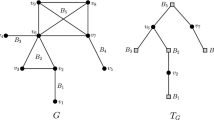Abstract
A graph G = (V,E) is called a circle graph if there is a one- to-one correspondence between vertices in V and a set C of chords in a circle such that two vertices in V are adjacent if and only if the corresponding chords in C intersect. A subset V′ of V is a dominating set of G if for all u ∈ V either u ∈ V′ or u has a neighbor in V′. In addition, if no two vertices in V′ are adjacent, then V′ is called an independent dominating set; if G[V′] is connected, then V′ is called a connected dominating set. Keil (Discrete Applied Mathematics, 42 (1993), 51–63) shows that the minimum dominating set problem and the minimum connected dominating set problem are both NP-complete even for circle graphs. He leaves open the complexity of the minimum independent dominating set problem. In this paper we show that the minimum independent dominating set problem on circle graphs is NP-complete. Furthermore we show that for any ε, 0 ≤ ε < 1, there does not exist an n ε-approximation algorithm for the minimum independent dominating set problem on n-vertex circle graphs, unless P = NP. Several other related domination problems on circle graphs are also shown to be as hard to approximate.
Access this chapter
Tax calculation will be finalised at checkout
Purchases are for personal use only
Preview
Unable to display preview. Download preview PDF.
Similar content being viewed by others
References
Sanjeev Arora and Carsten Lund. Hardness of approximation. In Dorit S. Hochbaum, editor, Approximation Algorithms for NP-hard problems. PWS Publishing Company, 1997.
T. A. Beyer, A. Proskurowski, S.T. Hedetniemi, and S. Mitchell. Independent domination in trees. Congressus Numerantium, 19:321–328, 1977.
K. S. Booth. Dominating sets in chordal graphs. Technical Report CS-80-34, Department of Computer Science, University ofWaterloo,Waterloo, Ontario, 1980.
K. S. Booth and J. H. Johnson. Dominating sets in chordal graphs. SIAM Journal on Computing, 13:335–379, 1976.
C. J. Colbourn and L. K. Stewart. Permutation graphs: connected domination and Steiner trees. Discrete Mathematics, 86:179–189, 1990.
D. G. Corneil and Y. Perl. Clustering and domination in perfect graphs. Discrete Applied Mathematics, 9:27–39, 1984.
Mirela Damian-Iordache and Sriram V. Pemmaraju. Domination in circle graphs with applications to polygon decomposition. Technical Report 99-02, University of Iowa, 1999.
A. K. Dewdney. Fast turing reductions between problems in NP, chapter 4: Reductions between NP-complete problems. Technical Report 71, Department of Computer Science, University of Western Ontario, London, Ontario, 1983.
M. Farber. Independent domination in chordal graphs. Operations Research Letters, 1:134–138, 1982.
M. Farber and J. M. Keil. Domination in permutation graphs. Journal of Algorithms, 6:309–321, 1985.
T. W. Haynes, S. T. Hedetniemi, and P. J. Slater. Fundamentals of Domination in Graphs. Number 208 in Pure and Applied Mathematics: A series of monomgraphs and textbooks. Marcel Dekker Inc., New York, 1998.
Robert W. Irving. On approximating the minimum independent dominating set. Information Processing Letters, 37:197–200, 1991.
D. S. Johnson. The NP-completeness column: an ongoing guide. Journal of Algorithms, 6:434–451, 1985.
J. Mark Keil. The complexity of domination problems in circle graphs. Discrete Applied Mathematics, 42:51–63, 1991.
D. Kratsch and L. Stewart. Domination on cocomparability graphs. SIAM Journal on Discrete Mathematics, 6(3):400–417, 1993.
R. Laskar and J. Pfaff. Domination and irredundance in split graphs. Technical Report 430, Clemson University, 1983.
Y. D. Liang. Steiner set and connected domination in trapezoid graphs. Information Processing Letters, 56:101–108, 1995.
M.R. Garey and D.S. Johnson. Computers and intractability: a guide to the theory of NP-completeness. W. H. Freeman and Company, New York, 1979.
J. Pfaff, R. Laskar, and S. T. Hedetniemi. NP-completeness of total and connected domination, and irredundance for bipartite graphs. Technical Report 428, Clemson University, 1983.
Author information
Authors and Affiliations
Rights and permissions
Copyright information
© 1999 Springer-Verlag Berlin Heidelberg
About this paper
Cite this paper
Damian-Iordache, M., Pemmaraju, S.V. (1999). Hardness of Approximating Independent Domination in Circle Graphs. In: Algorithms and Computation. ISAAC 1999. Lecture Notes in Computer Science, vol 1741. Springer, Berlin, Heidelberg. https://doi.org/10.1007/3-540-46632-0_7
Download citation
DOI: https://doi.org/10.1007/3-540-46632-0_7
Published:
Publisher Name: Springer, Berlin, Heidelberg
Print ISBN: 978-3-540-66916-6
Online ISBN: 978-3-540-46632-1
eBook Packages: Springer Book Archive




